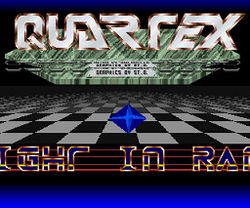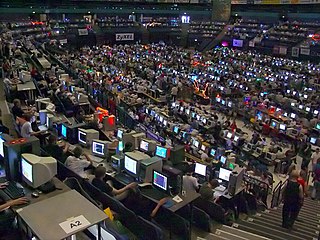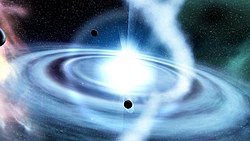
Amiga demos are demos created for the Amiga home computer.

A crack intro, also known as a cracktro, loader, or just intro, is a small introduction sequence added to cracked software. It aims to inform the user which "cracking crew" or individual cracker removed the software's copy protection and distributed the crack.

The demoscene is an international computer art subculture focused on producing demos: self-contained, sometimes extremely small, computer programs that produce audiovisual presentations. The purpose of a demo is to show off programming, visual art, and musical skills. Demos and other demoscene productions are shared at festivals known as demoparties, voted on by those who attend and released online.

The Assembly demoparty is a demoscene and gaming event in Finland. It is the biggest demoscene party. The main organizers of the event are Pekka Aakko and Jussi Laakkonen. The Summer event takes place every year between late July and early August, and lasts three to four days, and the Winter event is held in January or February. Edition 2020 was online. The most recent Assembly was held from 1 to 3 April 2022 at Messukeskus in Helsinki.

The Commodore 64 (C64) demos are demonstrations of what can be done to push the limits of the Commodore 64 computer, made by programmers, musicians and artists.

The Gathering is the second largest computer party in the world. It is held annually in Vikingskipet Olympic Arena in Hamar, Norway, and lasts for five consecutive days. Each year, TG attracts more than 5200 people, with attendance increasing every year.

Breakpoint was a German demoscene party. From 2003 to 2010, it took place annually at Easter in Bingen.

Second Reality is an IBM PC compatible demo created by Future Crew. It debuted at the Assembly 1993 demoparty on July 30, 1993, where it was entered into the PC demo competition, and finished in first place with its demonstration of 2D and 3D computer graphics rendering. The demo was released to the public in October 1993. It is considered to be one of the best demos created during the early 1990s on the PC; in 1999 Slashdot voted it one of the "Top 10 Hacks of All Time". Its source code was released in a GitHub repository as public domain software using the Unlicense on the 20th anniversary of the release on 1 August 2013.

Pilgrimage was a demoparty which took place annually in Salt Lake City, Utah each summer between 2003 and 2006. The event was founded by Rich "Legalize" Thompson of the demoscene group Polygony. Pilgrimage was, at the time, the only active demoscene event of its kind in all of North America, while many demoparties take place annually throughout Europe.
keWlers is a Finnish demogroup, formed in the early 1990s, originally called Mewlers. After smaller releases such as Tripfish 2 or Another High-Caliber Mechanical Complication, their breakthrough came in 2002 when they released their critically acclaimed demo Variform at Assembly 2002. Despite only achieving third place, the demo became one of the most widely known and top rated demos ever released, winning three Scene.org awards. Further major demos to be released later included Protozoa and A Significant Deformation Near The Cranium, released at Assembly 2003. Kewlers have been nominated for at least one Scene.org Award every year, except for 2004. The group disbanded for a while in 2006 directly after the release of their final demo, 1995. But since 2010 Kewlers have returned from their hiatus, with possibly Variform 2, released at Revision 2012, as their most influential demo since their comeback.

Hugi is one of the longest lasting, frequently released demoscene and underground disk magazines (diskmag) for IBM-PC.
Andromeda Software Development is a Greek demogroup that was formed in 1992. They produced a number of small intros and demos in the mid-1990s for the PC, most notably CounterFactual and Beyond. ASD was quiet for the following years until 2001, when they presented Cadence & Cascade - their first accelerated demo - and won the Digital Nexus demoparty, held in Athens, Greece.

Moppi Productions was a Finnish-based demogroup founded in 1996. It is mainly known for their story-based demos and the demo authoring tool Demopaja. The demo ix, released in 2003, won a total of three awards in the Scene.org Awards gala.

Demo effect is computer-based real-time visual effects found in demos created by the demoscene.

Very Important Party (VIP) is an annual demo party held from 1999 to 2002 in Saint-Priest, near Lyon (France) and from 2008 in Thoissey. It is organized by PoPsY TeAm, a French demogroup from Lyon area.
The ZX Spectrum's software library was very diverse. While the majority of the software produced for the system was video games, others included programming language implementations, Sinclair BASIC extensions, databases, word processors, spread sheets, drawing and painting tools, and 3D modelling tools.

The Nullarbor demo party is a combined game development and demoscene event in Australia. The event takes place at the beginning of every year in Perth, Western Australia. It was named Nullarbor in reference to Perth's physical isolation from the rest of Australia. Like other similar demo parties worldwide, it provides a platform for game developers and graphic artists to showcase their skills.
Wired was a Belgian annual demoparty which ran from 1994 to 1998. Typical competitions included PC and Amiga demos and intros, handmade and ray traced graphics, music and surprise competitions.

Razor 1911 (RZR) is a warez and demogroup founded in Norway, 1986. It was the first ever such group to be initially founded exclusively as a demogroup, before moving into warez in 1987. According to the US Justice Department, Razor 1911 is the oldest software cracking group that is still active on the internet. Razor 1911 ran the diskmag 'Propaganda' until 1995.
Phenomena (PHA) was a Swedish Demogroup making Amiga demos that was productive during the formative years of the Amiga Demoscene founded in 1987.








